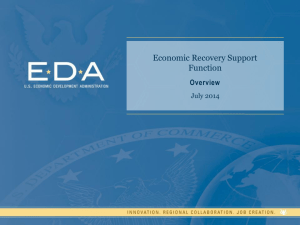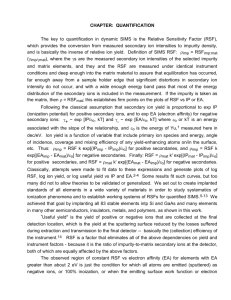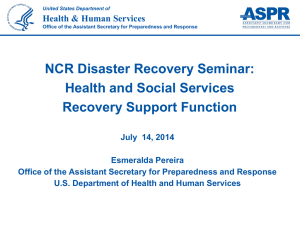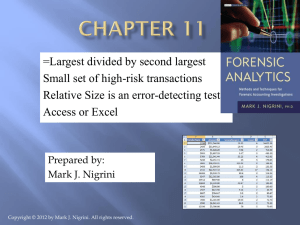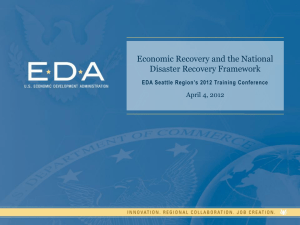CHAPTER: DEPENDENCE of SECONDARY ION MASS
advertisement
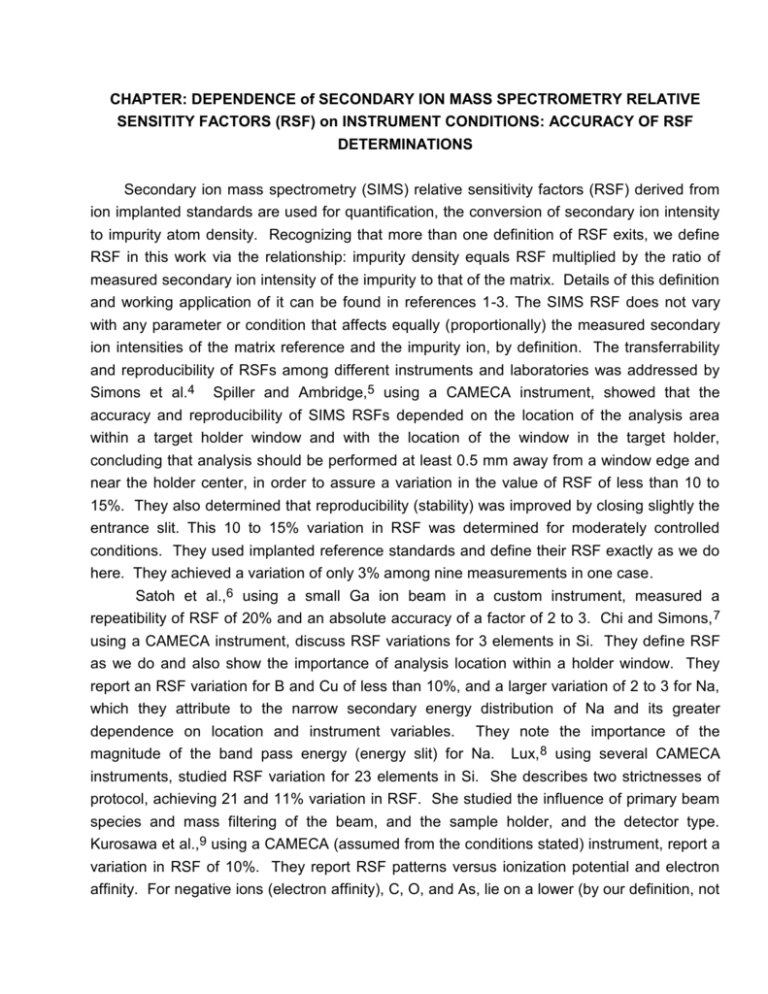
CHAPTER: DEPENDENCE of SECONDARY ION MASS SPECTROMETRY RELATIVE SENSITITY FACTORS (RSF) on INSTRUMENT CONDITIONS: ACCURACY OF RSF DETERMINATIONS Secondary ion mass spectrometry (SIMS) relative sensitivity factors (RSF) derived from ion implanted standards are used for quantification, the conversion of secondary ion intensity to impurity atom density. Recognizing that more than one definition of RSF exits, we define RSF in this work via the relationship: impurity density equals RSF multiplied by the ratio of measured secondary ion intensity of the impurity to that of the matrix. Details of this definition and working application of it can be found in references 1-3. The SIMS RSF does not vary with any parameter or condition that affects equally (proportionally) the measured secondary ion intensities of the matrix reference and the impurity ion, by definition. The transferrability and reproducibility of RSFs among different instruments and laboratories was addressed by Simons et al.4 Spiller and Ambridge,5 using a CAMECA instrument, showed that the accuracy and reproducibility of SIMS RSFs depended on the location of the analysis area within a target holder window and with the location of the window in the target holder, concluding that analysis should be performed at least 0.5 mm away from a window edge and near the holder center, in order to assure a variation in the value of RSF of less than 10 to 15%. They also determined that reproducibility (stability) was improved by closing slightly the entrance slit. This 10 to 15% variation in RSF was determined for moderately controlled conditions. They used implanted reference standards and define their RSF exactly as we do here. They achieved a variation of only 3% among nine measurements in one case. Satoh et al.,6 using a small Ga ion beam in a custom instrument, measured a repeatibility of RSF of 20% and an absolute accuracy of a factor of 2 to 3. Chi and Simons, 7 using a CAMECA instrument, discuss RSF variations for 3 elements in Si. They define RSF as we do and also show the importance of analysis location within a holder window. They report an RSF variation for B and Cu of less than 10%, and a larger variation of 2 to 3 for Na, which they attribute to the narrow secondary energy distribution of Na and its greater dependence on location and instrument variables. They note the importance of the magnitude of the band pass energy (energy slit) for Na. Lux, 8 using several CAMECA instruments, studied RSF variation for 23 elements in Si. She describes two strictnesses of protocol, achieving 21 and 11% variation in RSF. She studied the influence of primary beam species and mass filtering of the beam, and the sample holder, and the detector type. Kurosawa et al.,9 using a CAMECA (assumed from the conditions stated) instrument, report a variation in RSF of 10%. They report RSF patterns versus ionization potential and electron affinity. For negative ions (electron affinity), C, O, and As, lie on a lower (by our definition, not theirs) RSF line than other elements, in a similar relationship as reported in reference 3. Using an ESCALAB instrument and the same definition of RSF that we use, Strydom et al. 10 discuss RSF values for HgCdTe, but do not report variations or accuracies. However, they compare their values with others1 which shows variations in RSF among the two independent measurements (allowing for the instrument difference that they point out) of about 40%. Newbury and Simons11 analyzed NBS standards using a CAMECA instrument and show absolute RSF deviations for 15 elements that vary within ~20%, with 10 of the 15, varying within ~12%. They discuss other issues regarding SIMS standards. Lodding and Odelius 12 discuss an RSF pattern, secondary ion energy distributions, effect of offset voltage, and detection limits. Here we discuss the influence of SIMS measurement conditions and instrument parameters on RSF values for CAMECA IMS 3f, 4f, and 5f instruments using both oxygen and cesuim primary ion beams. Conditions addressed include primary ion impact energy (and associated angle of incidence), sputtering rate (primary ion current density), size (diameter) of contrast diaphragm, secondary ion species and various associated widths of secondary ion energy distribution, secondary ion intensity impurity or matrix), and location of analysis area within a sample holder (nearness to a sample holder edge). We have measured the influence of the secondary ion energy distribution of selected elements, namely K (narrow energy distribution), Mn (medium energy distribution), and Si (wide energy distribution), both as impurities and as matrix components on some of these variables. These results assume the use of the full 128 eV energy band pass of the electrostatic analyzer in the CAMECA instrument. This work is specifically quantitatively applicable to a CAMECA IMS instrument (sector magnet, high extraction voltage, 128 eV energy band pass, and mass independent detector system), and only qualitatively applicable to quadrupole instruments. We have measured weak systematic dependence of RSF on some of the above variables, but the magnitudes of the variations in RSF are of the order of a few to ~20%, individually [which are all within the ~30% accuracy that we quote for most RSFs]. The notable exception is the location of the analysis area within a sample holder window (nearness to a sample holder edge), which can cause variations of a factor of 50% to 2 or 3, or even 5 if the crater is placed near the corner of the window. If RSF measurements and quantified SIMS measurements are performed at least 1 mm away from a window edge, RSFs should be measurable to within ~30%, from instrument-to-instrument (magnetic sector with reproducible high fields) and time-to-time [for samples with accurate implant fluences or known doping densities, or the same round robin samples, for full 128 eV band pass energy, for conditions that do not saturate (more than a few percent) the secondary ion detector used]. Possible exceptions are elements with high ionization potential, low electron affinity, and that are easily desorbed, which include N, Hg, and the noble gases. These elements may be ionized above the surface,13 which may cause irregular or not easily reproducible secondary yields and therefore RSFs. RSFs for F (enhanced positive ion yield) are quite reproducible and consistent. Variation of RSF with primary beam energy and associated angle of incidence: This issue is discussed in Sections 1.2 and 1.3 of reference 2. For our standard operating condition of 6- or 8-keV O impact energy, the incidence angle is (40±1)°, and for 14.5-keV Cs energy, it is 26°. All RSF "standards" work has been carried out under these conditions, as stated in reference 2, so all of our RSFs and systematics are for these conditions. Variations in ion yield with angle of incidence may result from variations in the degree of incorporation of atoms of the primary beam and resulting changes in the surface work function, but if these yield changes are the same for impurity species and matrix reference element, then the RSF is not altered. This is essentially the case for O and Cs primary beams in the CAMECA instrument because of the results of the following experiments. We measured the dependence of RSF of B and F on primary O2 impact energies of 3.0, 5.5, 8.0, 10.5, and 13.0 keV in a CAMECA IMS 4f (corresponding angles of incidence of 52, 42, 9, 37, and 35°, respectively). The results show that the RSF varies ~15% for B and 33% for F over that range of values of primary impact energy (the full range on energies provided on the standard CAMECA instrument). Similar mesurements were made for Cs primary impact energies of 9.5, 12.0, and 14.5 keV (corresponding to angles of incidence of about 26, 25, and 24°, respectively) for S and As in Si. The results showed that the RSF varies by less than ~8% over this range of values of Cs impact energy. However, we specify the use of only 6- or 8keV O2+ impact energy, and only 14.5 keV Cs impact energy for RSF reference standards. Variation of RSF with sputtering rate: We measured the dependence of RSF on sputtering rate for 8-keV O2 primary ions and a 250m raster and a Si matrix over the range of sputtering rate that we normally use and that corresponds to primary O 2 beam currents from 0.1 to 10 A, or two orders of magnitude in sputtering rate. A slight systematic increase in RSF was measured over this range, but the total change was 12% over the two orders of magnitude, or ~6% within the total range over which we collect data. Variation of RSF with size (diameter) of contrast diaphragm (CD): We studied in detail a number of elements that have different energy distributions, including K, which has a narrow energy distribution, and Mn, which has a medium energy distribution, implanted into Si, with Si as the matrix reference, and measured the RSF using constrast diaphragms (CD) with diameters of 30, 85, 150, and 400 m (the four standard sizes in the CAMECA IMS instrument). We installed a set of four new apertures for the mesurement. The results show that the values of RSF measured for Mn for the three smaller CDs are within ~2%, and the value for the largest CD (400m) is 20% lower. If all four values of RSF are combined, the composite error is ~12%, which is still within the accuracy stated for RSF. [If only the three smaller CDs are used, the error in RSF is negligible (within measurement accuracy - the ~2%.] For K, the values of RSF measured for the three smaller CDs varied ~13%, with no consistent trend with CD size. The 400 m CD could not be used because the secondary intensity of K+ from the reference standard would have saturated the electron muiltiplier detector. This is nearly always the case, and the 400 m CD would almost never be used for analysis of K+. Some errors in RSF measurement may result because some analysts may try to use the 400 m CD or more intense secondary ion intensities and may not be careful to check or understand the effect of detector dead time/detector saturation. Variation of RSF with location of the analysis area within a sample holder window: The effect of location of the analysis area within a sample holder window on RSF and on energy distribution is very significant -- up to factors of 2 or 3, or even 5 if the analysis is performed in the corner of a holder window. If analysis is performed more than 1 mm from a sample holder edge, The variation (reproducibility) of RSF is within ~20%. Moving from the center toward an edge of the window cuts off the low energy portion of the energy distribution and therefore affects impurities with narrow energy distributions more than those with wide distributions (determined from corresponding measurements of secondary ion energy distributions). Deline14 has also reported this observation. For combinations like K in Si, the RSF is affected. This may explain why RSFs for combinations like K in Si vary among workers/laboratories; analyses may not all have been performed more than 1 mm away from a sample holder egde. Elements that may be ionized above the sputtering surface, like N, Hg, and the noble gases, He, Ne, Ar, Kr, and Xe (high IP, low EA, and high vapor pressure), may be more affected by this situation and exhibit less consistent RSFs. In summary, the dependences of RFS on selected instrument/analysis conditions in a CAMECA IMS instrument, in terms of error or uncertainty are: primary ion energy: O2 - 10%; Cs - 15% sputtering rate: 15% CD size: 5 or 10% analysis location: 10 to 300% impurity species: 20% Total (for centered analysis location and corresponding 10 or 20%, and the full range of the above variables: 50 or 60%. We15 have checked reproducibility of RSF for most elements from H to U. Additional issues and comments that might be useful to a user Effects may occur at the ion-mixed sputtering surface of the matrix from which both matrix and impurity ions are sputtered. The extraction, focusing, and transmission optics must be considered. Finally, detector issues must be considered. In the Cameca magnetic sector instrument, in which the extraction and focusing fields are relatively large, these issues are different from those in the weaker field quadrupole instruments. In reference 2, most of the issues that affect the measurement accuracy of SIMS are discussed. However, we have carried out additional measurements to check further or substantiate some of our statements - for the magnetic sector instrument -- for which the present work is relevant, and upon which the prior RSF systematics of atomic and now molecular ions are based. 1-3 In reference 2, we state that the primary cause of variations in RSF -- reproducibility from time-to-time, from instrument-to-instrument, from sample-to-sample, etc., is the location of the analysis area (crater) within a sample holder window. This has once again been demonstrated, but with greater quantitative details. Location of the analysis area within the sample holder window is the only experimental parameter that causes significant (>25%) variation in SIMS RSF values, using the standard full 128 eV band pass energy, and with the energy slits centered, which is the condition for our RSF measurements. It is important to use certain matrix reference elements for consistent, reproducible RSFs, for example, As for GaAs, P for InP, Te for HgCdTe, i.e., the column V or VI element for III-V or II-VI materials, respectively, and Si for SiO2 or Si3N4. It is important not to use elements that do not produce consistent RSFs as impurities (in Si, for example), namely N, Hg, or other elements that have high IP, low EA, or are gases or are volatile. It is important not to saturate the matrix reference signal during RSFs determinations, or RSFs that are too low will be recorded. It is important not to saturate the detection electronics, so elements with low ionization potential are sometimes not good choices for positive secondary ion mass spectrometry, elements such as Al, Ga, or In, which are common in III-V materials. When measuring detection sensitivities, it is important that a low fluence implant be used -- a fluence that yields a maximum impurity density that is no more than about four decades above the actual background signal (instrument background), or a detection limit that is too high will be recorded. We generally use implant standards that have fluences of 1013 to 1014 cm-3 to avoid creating a detection limit that is caused by sputtering memory in the instrument rather than the true background at the mass of interest. In contrast, when studing an element that has low detection sensitivity, we use implant standards that have higher fluences, namely 10 15 to 1016 cm-3, in order to detect secondary ions of the impurity. We use implanted standards of the rare isotopes of some elements in order to enhance the detection sensitivity and detection limits of certain elements, which certainly include the ambient gas or atmospheric elements, and combinations of them or molecular interferences at their masses (H, C, N, O, Si, S). The use of these masses also greatly reduces the signal at the surface caused by surface contamination for some masses. We use higher energies for implant standards to place the peak of the depth profiles deeper than the SIMS equilibration depths, especially for higher atomic number elements. All of the above mentioned issues account for some of the consistency and reproducibility of RSFs that we measure and report. We believe that anyone who observes these procedures and uses the full 128 eV energy band pass and does not perform an analysis for quantification near a sample holder edge can achieve RSFs that are consistent and reproducible within ±30%, except for the elements noted. Issues such as the purity of the primary ion beam and dependence of collector efficiency on ion mass for an electron multiplier are not addressed here. We assume that adequate primary beam mass separation and calibrated electron multiplies (or well designed Faraday cups) are used for RSF determinations. The issue of the effect of any charging during the determination of RSFs for insulators is left for another treatment; this work applies to targets that do not charge significantly during SIMS analysis. We have measured secondary ion energy distributions under various conditions for several elements as both impurities and as matrix elements (metals, semiconductors, and insulators) and for elements with relatively narrow energy distribution (K), medium width distribution (Mn), and relatively wide distributions (Si). K was measured as a matrix element (high intensity) for KTaNbO 3, Mn for a Mn-Zr alloy, and Si from crystalline Si. We have measured energy distributions for elements that have most of their distribution in negative potential region (Hg), most in the positive potential region (Si, As), and fairly symmetrically split between positive and negative regions (Te). The results for matrices like BN (an insulator) and HgCdTe were especially interesting. These results, considered in total, show that the 128 eV energy band pass passes >99% of secondary ions with narrow or medium widths, and >95% of the distributions for elements with wide distributions, such as Si -- by integration of the energy distributions. References: 1. R.G. Wilson, J. Appl. Phys. 63, 5121 (1988) 2. R.G. Wilson, F.A. Stevie, and C.W. Magee, Secondary Ion Mass Spectrometry [Wiley, New York, 1989] 3. R.G. Wilson and S.W. Novak, J. Appl. Phys. 69, 446 (1991) 4. D.S. Simons, P.H. Chi, P.M. Kahora, G.E. Lux, J.L. Moore, S.W. Novak, C. Schwartz, S.A. Schwarz, F.A. Stevie, and R.G. Wilson, Secondary Ion Mass Spectrometry SIMS VII, A. Benninghoven, C.A. Evans, K.D. McKeegan, H.A. Storms, and H.W. Werner, Eds. [Wiley, NY, 1990] pp. 111-114. 5. G.D.T. Spiller and T. Ambridge, Secondary Ion Mass Spectrometry SIMS V, A. Benninghoven, R.J. Colton, D.S. Simons, and H.W. Werner, Eds. [Springer, Berlin, 1986] p. 127 6. H.Satoh, M. Owari, and Y. Hihei, Secondary Ion Mass Spectrometry SIMS VII, A. Benninghoven, C.A. Evans, Jr., K.D. McKeegan, H.A. Storms, and H.W. Werner, Eds. [Wiley, NY, 1990] p. 91 7. P.H. Chi and D.S Simons, SIMS VII, ibid., p.126 8. G. Lux, SIMS VII ibid, p. 123. 9. S. Kurosawa, Y. Homma, T. Tanaka, and M. Yamawaki, Secondary Ion Mass Spectrometry SIMS IV, A. Benninghoven, J. Okano, R. Shimizu, and H.W. Werner, Eds., [Springer, Berlin, 1984] p. 107 10. H.J. Strydom, A.P. Botha, C.A. Strydom, and J.S. Vermaak, SIMS VII, ibid., p.163 11. D.E. Newbury and D.S. Simons, SIMS IV, ibid., p. 101 12. A. Lodding, H. Odelius, and L.G. Petersson, SIMS IV, ibid., p.478 13. V.R. Deline, Analytical Electron Microscopy 1987 (Proceedings of the Microbeam Analysis Society), D.C. Joy, Ed. [San Francisco Press, San Francisco, 1987], 269-70 14. R. Holland and G.W. Blackmore, Surface and Interface Analysis 4, 174 (1982) 15. F.A. Stevie is included in this RSF check. Other Bibliography Y. Homma, S. Kurosawa, Y. Kubota, Y. Nakamura, K. Nomura, M. Shibata, H. Shichi, J. Takahashi, Y. Yoshioka, and T. Ogawa, SIMS VII, ibid., p.119 Y. Homma, Secondary Ion Mass Spectrometry SIMS VI, A. Benninghoven, A.M. Huber, and H.W. Werner, Eds. [Wiley, NY, 1988] p. 717 MBernhein and G. Slodzian, SIMS VII, ibid., p.139 P. Roitman, D.S. Simons, P.H Chi, R.M. Lindstrom, G.E. Lux, S. Baumann, S.W. Novak, R.G. Wilson, D. Farrington, J. Keenan, F.A. Stevie, J.L. Moore, R.B. Irwin, A.J. Filo, C.W. Magee, R. Alcorn, and D. File, "Round-robin study of implants in Si and SiO2 using SIMS, RBS, and NAA," Secondary Ion Mass Spectrometry SIMS VII, A. Benninghoven, C.A. Evans, K.D. McKeegan, H.A. Storms, and H.W. Werner, Eds. [Wiley, NY, 1990], pp. 115-117
